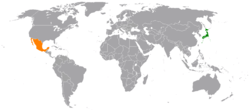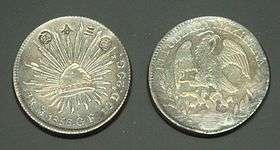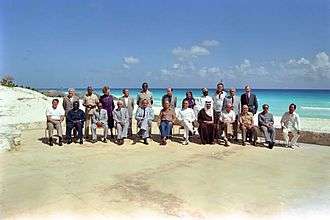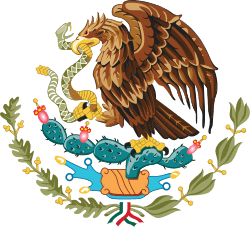Japan–Mexico relations
 |
|
Japan |
Mexico |
|---|---|
Japan–Mexico relations refers to the diplomatic relations between Japan and Mexico. Both nations are members of the Asia-Pacific Economic Cooperation, G-20 major economies, Organisation for Economic Co-operation and Development and the United Nations.
History
Under Spanish colonial rule, Mexico, then known as New Spain; controlled the trade routes between Manila, capital of the Philippines and the Mexican port of Acapulco. Through this trade route, Spanish galleons sailed from Acapulco to the Philippines and traded with neighboring countries/territories within the vicinity. Some of those territories were the islands of Japan. In Manila, Japanese trading boats would arrive and bring goods and food to trade with the New Spanish government.[1] From Manila, Spanish vessels would transport the goods back to Acapulco, traverse the Mexican terrain until they reached the port of Veracruz and from there transport the goods onto another Spanish vessel to Spain.
In the mid-1500, Spanish Jesuits, many of them born in New Spain, began to arrive to Japan to preach Christianity. In 1597, general Toyotomi Hideyoshi, who is accredited with uniting the islands of Japan; prohibited the teaching of Christianity and ordered all missionaries to leave Japan. Several Jesuits did not leave and they were executed in Nagasaki.[2]
.jpg)
In 1609, a Spanish galleon called San Francisco capsized near Ōtaki, Chiba while making its way from Manila to Acapulco. 370 castaways were rescued by Japanese fisherman. Among those rescued was the New Spanish governor of the Philippines; Rodrigo de Vivero. In Japan, de Vivero was able to travel to Tokyo and met with high level dignitaries and establish direct commercial relations between Japan and the Spanish empire via the Philippines. After spending some time travelling throughout the Japanese islands, de Vivero returned to Acapulco with a new ship built in Japan called the San Buenaventura and with some Japanese men on board. Once in Acapulco, de Vivero brought his mission to Mexico City and met with the Spanish viceroy, Luis de Velazco and communicated to him his report. In March 1611, the Spanish viceroy Veleazco sent a mission directly from Acapulco to Japan thanking the Japanese government for assisting his governor de Vivero and reimbursed them for the ship San Buenaventura, and giving them gifts in homage, one of them being a clock made in Madrid and it was to be the first clock that people of Japan had ever seen before.[2]
In October 1613, the first Japanese diplomatic mission was sent to New Spain by Masamune Date, a regional strongman. This diplomatic mission was to be known as the Keichō embassy and it was the second diplomatic mission to travel to Europe after the first historic mission known as the Tenshō embassy. Date had built a new exploration ship called the Date Maru or San Juan Bautista which was to take the diplomatic party to the Americas. The ambassador, Hasekura Tsunenaga traveled from Japan to Acapulco and met with the Spanish viceroy Diego Fernández de Córdoba. In Mexico City, Hasekura met with several colonial leaders and offered the New Spanish government free commerce between the New Spanish territories and Japan and asked for a group of Christian missionaries to return to Japan. The diplomatic mission also offered to expel both English and Dutch citizens from the country because both nations were considered at the time to be enemies of the Spanish king. In June 1614, Hasekura left New Spain via Veracruz and continued on his journey to Spain to meet with the Spanish king leaving behind a small delegation. In Spain, Hasekura was baptized a catholic and changed his name to Francisco Felipe Faxicura. Two years later in February 1617, Hasekura/Faxicura returned from Spain to Veracruz and traveled to Mexico City. Upon arrival to Mexico City, Hasekura was surprised to see that most members of his delegation that he had left behind, had married and integrated into the local community. In 1618, Hasekhura and his diplomatic mission set sail and returned to Japan. On arrival, they were confronted with the fact the country had dramatically changed since their departure in 1613 and that anything related to Christianity had been banned. Hasekura and his delegation had to renounce their adopted religion. Since Hasekura's diplomatic mission to New Spain, Japan entered a time of isolation and refused to trade with foreign nations.[1]

In 1874 (fifty-three years after Mexico declared independence from Spain in 1821), a Mexican scientific delegation headed by Francisco Díaz Covarrubias arrived in Japan to witness the transit of the planet Venus through a solar disc. Although the scientific delegation did not have much success, this mission did allow for formal diplomatic relations to begin between the two nations. In 1888 Foreign Ministers Matías Romero and Munemitsu Mutsu signed a Treaty of Amity, Commerce, and Navigation; which was to be Japan's first "equal" treaty with a foreign nation and thus formally established diplomatic relations between the two nations.[2][3]
Since establishing diplomatic relations, contact between the two nations increased through trade and commerce. In May 1942, Mexico declared war on the Axis Powers, which included Japan, and joined World War II. The Escuadrón 201 was a squadron of fighter planes that fought against Japanese pilots at the Battle of Luzon, in the Philippines. After the war, diplomatic relations were restored and have continued unabated ever since.
State visits


Royal and Prime Ministerial visits from Japan to Mexico[4]
- Prime Minister Nobusuke Kishi (1959)
- Prince (current Emperor) Akihito (1964)
- Prime Minister Kakuei Tanaka (1974)
- Prime Minister Masayoshi Ōhira (1980)
- Prime Minister Zenkō Suzuki (1981)
- Prime Minister Toshiki Kaifu (1989)
- Prince Naruhito (1992, 2006)
- Prime Minister Ryutaro Hashimoto (1996)
- Prince Fumihito Akishino (1997)
- Prime Minister Junichiro Koizumi (2002, 2004)
- Prime Minister Yoshihiko Noda (2012)
- Prime Minister Shinzō Abe (2014)
Presidential visits from Mexico to Japan
- President Adolfo López Mateos (1962)
- President Luis Echeverría Álvarez (1972)
- President José López Portillo (1978)
- President Miguel de la Madrid Hurtado (1986)
- President Carlos Salinas de Gortari (1990, 1993)
- President Ernesto Zedillo (1995, 1997, 1998)
- President Vicente Fox (2001, 2003)
- President Felipe Calderón (2008, January and November 2010)
- President Enrique Peña Nieto (2013)
Trade
In April 2005, Japan and Mexico signed a free trade agreement (a.k.a. Agreement Between Japan and the United Mexican States for the Strengthening of the Economic Partnership). Since then, trade between the two nations has increased dramatically. In 2014, trade between the two nations amounted to $20 billion USD.[5] Most of the trade is in agricultural products, alcohol and automobile parts. Between 2005 - 2012, Japanese companies invested over $12 billion USD in Mexico, mainly in the automobile industries.[6]
Resident diplomatic missions
- Japan has an embassy in Mexico City and a consulate-general in León.[7]
- Mexico has an embassy in Tokyo.[8]
Education
The Liceo Mexicano Japonés, a Japanese-Mexican school, serves elementary through high school students, including Mexican and Japanese nationals, residing in Mexico City.
See also
References
- 1 2 Bilateral relations between Japan and Mexico (in Spanish)
- 1 2 3 History of Mexico and Japan (in Spanish)
- ↑ Japan-Mexico Relations (Basic Data)
- ↑ Cronología de la relación México - Japón (in Spanish)
- ↑ Mexican Ministry of the Economy: Japan (in Spanish)
- ↑ Japanese investment in Mexico (in Spanish)
- ↑ Embassy of Japan in Mexico City (in Japanese and Spanish)
- ↑ Embassy of Mexico in Tokyo (in Japanese and Spanish)
External links
- Mexican Ministry of Foreign Affairs on Mexico-Japan relations (in Spanish)
- Japanese Ministry of Foreign Affsirs on bilateral relations between Japan and Mexico (in Spanish)
- Mexico-Japan: Four hundred years of friendship (in Spanish)
- Basic data on Japanese-Mexican relations

